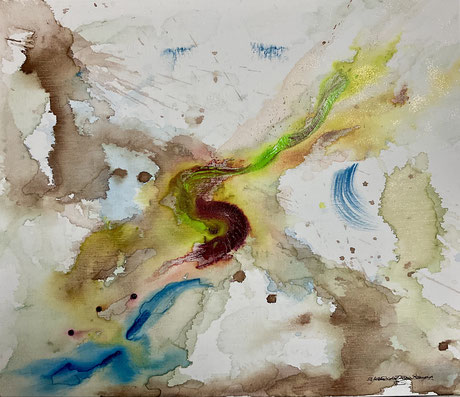「絵画表現とは」
表現とは簡単に変わらない。
これでもか、これでもか、と日々絵を描いて、やっと表現は深まって行く。
しかし結局のところ、行き着くところに行き着かない。
絵画制作は終わりのない旅である。
もちろん小手先のテクニックは日々磨き続ける必要はあるが、根幹は思想だ。
その絵を描くための自分の根幹、つまり思想が絵画を変えて行く。
もちろん感情に表現は左右される。
絵は描いているその時々の感情が筆に伝わり、ダイレクトに筆跡として残るからである。
つまり、思想と感情が絡み合ったものが絵画表現だ。
しかし思想が感情よりも大事だ。
思想がある種の思い込みを作り、何をどう描くかが変わる。
思想が、表現上の色や形や構図、画面構成を変えて行くのである。
思想は実体験により日々流れを変え、終わりがない。
だから絵画にも終わりが訪れないのである。
例えば、同じ犬を描くとしても、作者にとって犬という存在が、思想的に可愛いのか怖いのかで絵が変わってしまう。
また、時代を具象的に描くにしても、政治に対する思想が体制的か、反体制的かでも絵がガラリと変わってしまう。
はたまた、闇に対する思想が変わるだけで、真っ黒だったものが、グラデーションされたり彩色されて変わることがある。
そのように、絵画表現は思想に基づき形を変えるのである。
"What is pictorial expression?"
The expression does not change easily.
Even with this, I draw pictures every day, and finally the expression deepens.
But in the end, it doesn't get there.
Painting is a never-ending journey.
Of course, it is necessary to continue refining the technique of small hands every day, but the basis is thought.
Your basis for drawing the picture, that is, the thought, changes the picture.
Of course, the expression depends on the emotion.
This is because the emotions of the painting are transmitted to the brush and remain directly as handwriting.
In other words, a pictorial expression is an intertwining of thought and emotion.
But thought is more important than emotion.
Thoughts make certain beliefs and change what and how to draw.
Thought changes the color, shape, composition, and screen composition of objects in terms of expression.
Thought changes every day by actual experience, and there is no end.
That is why the painting never ends.
For example, even if you draw the same dog, the picture will change depending on whether the existence of a dog is ideologically cute or scary.
Also, even if the era is depicted concretely, the picture will change completely depending on whether the idea of politics is systematic or dissident.
Also, just by changing the way of thinking about darkness, what was black may be changed by gradation or coloring.
In that way, pictorial expression changes its shape based on thought.

